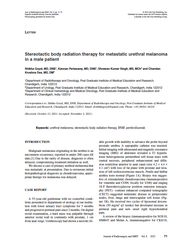- Home
- Journal Contents Downloads
- JRSBRT Downloads
- JRSBRT 8.1, p. 21-26
Product Description
Purposeful irradiation of the epidural space to enhance local control without compromising cord sparing in spine radiosurgery
P. James Jensen, Jordan A. Torok, C. Rory Goodwin, Scott R. Floyd, Qiuwen Wu, Q. Jackie Wu and John P. Kirkpatrick
Purpose: The epidural space is a frequent site of cancer recurrence after spine stereotactic radiosurgery (SSRS). This may be due to microscopic disease in the epidural space which is underdosed to obey strict spinal cord dose constraints. We hypothesized that the epidural space could be purposefully irradiated to prescription dose levels, potentially reducing the risk of recurrence in the epidural space without increasing toxicity.
Methods and materials: SSRS clinical treatment plans with spinal cord contours, spinal planning target volumes (PTVspine), and delivered dose distributions were retrospectively identified. An epidural space PTV (PTVepidural) was contoured to avoid the spinal cord and focus on regions near the PTVspine. Clinical plan constraints included PTVspine constraints (D95% and D5%, based on prescription dose) and spinal cord constraints (Dmax < 1300 cGy, D10% < 1000 cGy). Plans were revised with three prescriptions of 1800, 2000 and 2400 cGy in two sets, with one set of revisions (supplemented plans) designed to additionally target the PTVepidural by optimizing PTVepidural D95% in addition to meeting every clinical plan constraint. Clinical and revised plans were compared according to their PTVepidural DVH distributions, and D95% distributions.
Results: Seventeen SSRS plans meeting the above criteria were identified. Supplemented plans had higher doses to the epidural low-dose regions at all prescription levels. Epidural PTV D95% values for the supplemented plans were all statistically significantly different from the values of the base plans (p < 10−4). The epidural PTV D95% increases depended on the initial prescription, increasing from 11.52 to 16.90 Gy, 12.23 to 18.85 Gy, and 13.87 to 19.54 Gy for target prescriptions of 1800, 2000 and 2400 cGy, respectively.
Conclusion: Purposefully targeting the epidural space in SSRS may increase control in the epidural space without significantly increasing the risk of spinal cord toxicity. A clinical trial of this approach should be considered.
Keywords: Spine, metastasis, stereotactic radiosurgery, epidural space, tumor control probability, normal tissue complications
After payment has been processed for your order of a digital copy (PDF) of this article, you will see a download link on your completed order page and also receive an email containing a download link. The links, which will enable you to download one copy of the article, will expire after 24 hours.
 Loading... Please wait...
Loading... Please wait...








